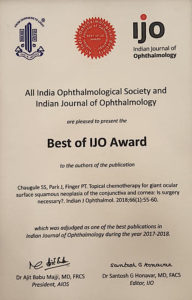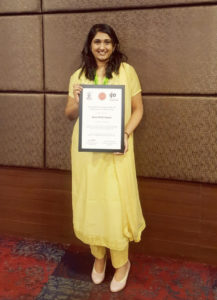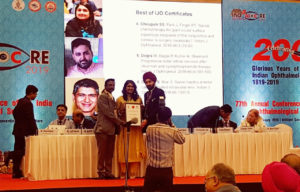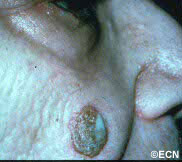ECF Research wins Best of IJO Award!
 In January of 2018, ECF fellow Dr. Sonal Chaugule, alongside Dr. Paul Finger and Dr. J. Park, published the study “Topical Chemotherapy for Giant Ocular Surface Squamous Neoplasia (OSSN) of the Conjunctiva and Cornea: Is Surgery Really Necessary?” in the Indian Journal of Ophthalmology (IJO). We are pleased to announce that this research has recently been chosen for the Best of IJO Awards!
In January of 2018, ECF fellow Dr. Sonal Chaugule, alongside Dr. Paul Finger and Dr. J. Park, published the study “Topical Chemotherapy for Giant Ocular Surface Squamous Neoplasia (OSSN) of the Conjunctiva and Cornea: Is Surgery Really Necessary?” in the Indian Journal of Ophthalmology (IJO). We are pleased to announce that this research has recently been chosen for the Best of IJO Awards!
A feature at the recent International Society for Ophthalmic Oncology (ISOO) 2019 meeting, the 2017 American Academy of Ophthalmology (AAO) meeting, as well as our very own blog and Visionary newsletter, the study showed the surprising efficacy of chemotherapy eye drops. They found that even large squamous cancers of the conjunctiva can be cured with chemotherapy eye drops alone (no surgery). The drops had marvelous results: no  evidence of vision-limiting complications, no tumor recurrences, and no patients required additional treatment for their giant OSSN. For all patients in the study, their cancer was cured, proving to researchers that topical chemotherapy drops were not only safe, but also effective as treatment for “giant” OSSN.
evidence of vision-limiting complications, no tumor recurrences, and no patients required additional treatment for their giant OSSN. For all patients in the study, their cancer was cured, proving to researchers that topical chemotherapy drops were not only safe, but also effective as treatment for “giant” OSSN.

To read the full study, click here.
To help sponsor ECF research and charitable endeavors, click here.










